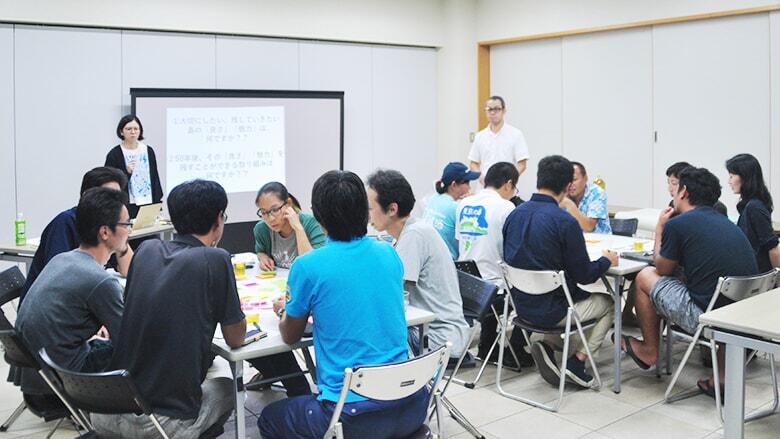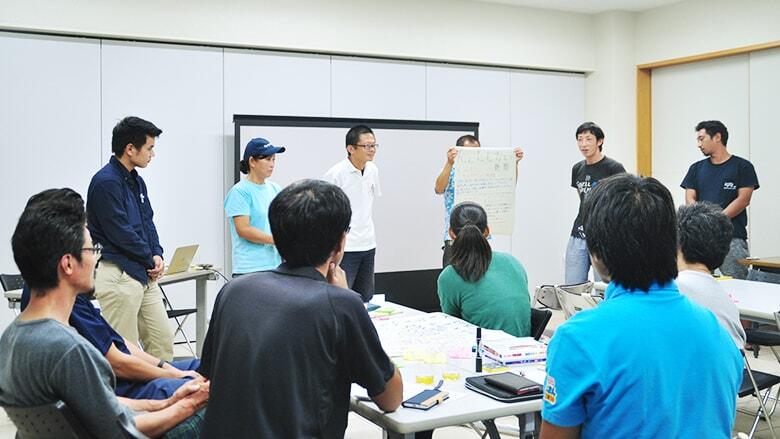The Tokyo Treasure Islands Project was launched in 2018 with the aim of further expanding the appeal of Tokyo's islands by making even more effective use of their wonderful scenery, local specialties, culture, and other attributes. The residents of the 11 islands in the Pacific that form part of the Tokyo Metropolis have taken the lead in this initiative to create, refine, and broadly publicize the Tokyo Treasure Islands brand and generate added value for the islands. As part of the project, the four islands of Oshima, Kozushima, Miyakejima, and Hachijojima are each holding a series of five Island Meetings in fiscal 2018 to discuss branding.

The first Island Meeting on Kozushima was held on September 25 in the Macchare Center conference room. Eleven participants gathered for the meeting from a variety of sectors including primary industries such as fishing, as well as the tourism industry, including guest houses, restaurants and eco-tour guiding.
The session started with welcoming remarks and an explanation of the goals and annual schedule for Island Meetings. Time was then allowed for an icebreaker, so that participants could share background information on their respective activities before the main discussion began.
For this purpose, participants split into five groups of three and asked each other questions before introducing one another to the whole meeting. The exercise provided a valuable opportunity to learn in more detail about others' work and activities. As participants got reacquainted and talked more about their activities and ideas, they discovered points in common.
Each group also presented a collaboration plan drawing on members' different fields of business to address the theme of "making the island more attractive." A range of distinctive ideas emerged that reflected members' specialist skills, including cooking classes at guest houses using local specialties such as island vegetables and fish, and new tours enabling visitors to dive in the ocean with a fisher and a diving guide, eat fish, and view the night sky.
This was followed by a presentation on branding by The TMG Bureau of General Affairs (the secretariat of the Island Meetings) to provide a deeper understanding of island branding, which is the objective of the Island Meetings. As a specific example, the presentation included an outline of initiatives by Okinoerabu-jima island (Kagoshima Prefecture).

Participants then split into two groups for group work where each member listed "island treasures" that he or she wanted to pass on to the future before the individual groups discussed and summarized them on a single wall newspaper. Imagining themselves 50 years in the future, the groups came up with three news stories each about positive island features and attractions that had been successfully preserved, created actual newspapers, and presented them in turn.
Team A called its newspaper the "Tenjo Times," after Mt. Tenjo, a symbol of the island that towers over central Kozushima. It dealt with island attractions including kinmedai (splendid alfonsino), Mt. Tenjo, obsidian, passionfruit, spring water, and the local dialect. It was notable for its unique perspectives on issues such as deep-sea aquaculture proposed as a solution to the sense of crisis over possible future depletion of kinmedai, which is a core catch for Kozushima's fishing industry; discovery of new technologies using obsidian, which has been taken from the island since ancient times; and the nature of the island as a great place to raise children.
The title of Team B's newspaper was the "Nndashikai News." In the island dialect, "Nndashikai" is a term often used to indicate agreement and understanding when speaking to others. The team came up with three news items on things that should be preserved 50 years from now, dealing with not only the rich natural environment of the island including its sea, mountains, and animals, but also cultural attributes such as island myths and traditional events, and relationships between island residents characterized by the cherishing of children and old people.
Having heard the presentations, the secretariat summarized their content by noting that both teams had presented views based on current issues. The things people want to preserve are also present-day challenges. Thinking about what we want to leave for the future is the first step towards solving today's problems.


